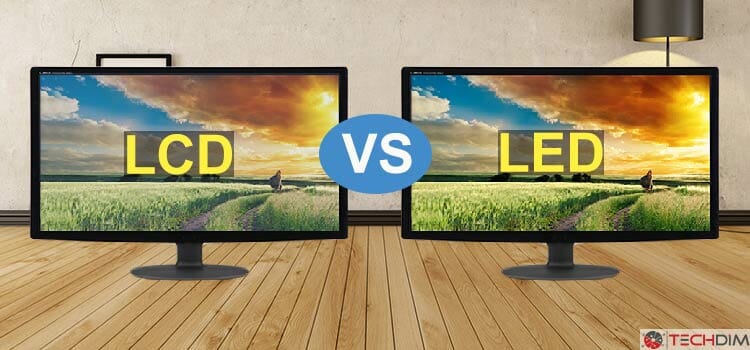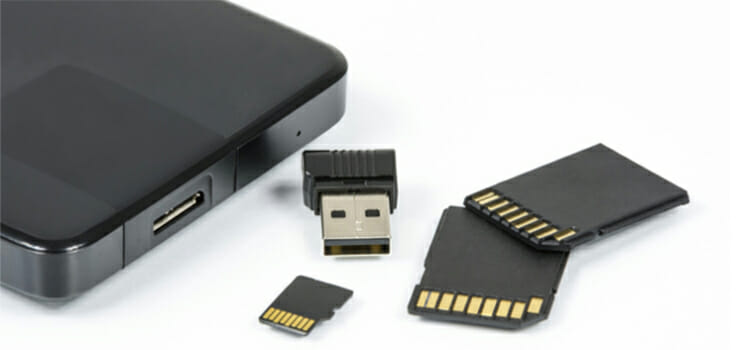LED vs LCD Monitor | Difference Between Them – Which One Is Better !!
If you are in the market for a new monitor, you probably are wondering which one to get, LED or LCD, and more importantly, what’s the difference between them.
Well, the main difference between them lies in the source of light. While LCD displays use a separate fluorescent light source, LEDs are made with light-emitting diodes, so it doesn’t require a separate light source.
For a more detailed difference, continue reading below.

What is an LCD?
LCD display stands for liquid crystal display.
It operates by applies different voltages on a layer of liquid crystal. This changes the crystal’s optical properties which allows for it to display different colors. LCDs are the most commonly used display for TVs, monitors, gaming displays, camera displays, etc.
They are cheaper to manufacture and mass-produce.
Here is a good quality budget-friendly IPS LCD monitor we found for you. You can use this as an LCD television too. If you are fond of playing games or watching movies or you may be a graphic designer, this monitor can help you do your job perfectly. This 24-inch LCD screen monitor has a 60Hz refresh rate 1080p resolution IPS panel which is perfect in this price range. The pixel density can also be better.
[aawp box=”B0148NNKTC” description=”none” template=”horizontal”]
What is an LED?
LED stands for light-emitting diode, an electronic component, and actually, means LED-backlit LCD TV. When electricity flows between the diodes, they produce light. They are more energy efficient but a bit costlier than LCDs.
Are you thinking about buying a 27 inch LED monitor or TV for a better visual experience, then check the following monitor from Dell. It is a 60Hz monitor which will be able to give you a better quality video watching experience. We hope you won’t regret buying it.
[aawp box=”B07KW6HFD1″ description=”none” template=”horizontal”]
In the next section, you will know the difference between led and LCD monitors.
LED vs LCD Monitor – Which one is better
Both kinds of displays involve the use of a panel consisting of two layers of sheets of polarizing material with a crystal solution in between. Let’s see the difference between them and which is better for LED or LCD monitors.
Backlighting
CCFL: The cold cathode fluorescent lamps (CCFL) were used in the past in order to light up the crystal solution on its way forward. The use of this backlighting technology is now out of date though some manufacturers still produce them. The reason it is abandoned is that the CCFLs are thicker than LEDs. These lamps, set serially inside, illuminate the whole screen equally and so an equal level of brightness is observed throughout the screen. Such LCDs are cheaper to make.
Full Array
Full-array LED LCD TVs are the modern LED TVs where the LCD screen is illuminated by an array full of LEDs. The use of LED in lieu of CCFL has marked the difference between LED and LCD and has caused the “LCD vs LED display” discussion to come into being. Anyways, this newer technology has become a favorite due to the fact that it ensures precise and even illumination i.e.it has to offer the illumination you want. Furthermore, it causes fewer bills for you to count in comparison to the CCFL LCDs.
Lighting
Lighting in LCD is of two types. In LCD TVs the sources for illumination of the screen are placed just behind the screen only. On the other hand, in LED TVs the light may come from behind or from the edges.
Dimming
The screen and hence the pictures are dimmed in an LED TV by dimming the LEDs behind it or on the edges. This sets the contrast of the picture quality. Local dimming is something the full array LED TVs or monitors have to offer as the light sources are under direct supervision over local areas of the screen. But edge-lit ones may show dark lines or areas on the screen owing to any blockade while setting the contrast. LCD TVs or specifically the CCFL LCD TVs lack such features. The dimming may be done to a minimal range by lowering the current through it. But, practically speaking, it reduces the lifespan of CFL lamps. So, you do not want your TV to worn out so shortly, do you?
Direct or edge-mounted
It depends on which factor you are concerned about when buying a TV or monitor. LED backlighting is of two types: direct and edge mounted. Direct backlighting enables you to control the contrast level by turning the local lights behind the screen on and off. Edge mounted technology helps get you the thinnest display. But you have to lose your control over the contrast level as an opportunity cost. Additionally, you may suffer from the picture quality if the dispersion of light is not well.
Viewing angles
Viewing angles primarily depend on the type of LCD panel you use. But still, as the brightness, contrast, and black levels depend on the lighting technology, they have an effect on this particular issue. LED has an upper hand again in this case as well. The challenge, in this case, is minimizing the rate of change of hue, saturation and retaining the actual combination of the red, green, and blue (RBG) percentage of a particular picture irrespective of your angular position with respect to the central point of the screen which is often considered the “sweet spot”.The changes are lesser for the VA (Vertically aligned) screens than IPS (in-place switching) screens or TN (twisted nematic) screens. LCD monitors come up with IPS screens while the LED LCD ones have VA screens in front. So, guess who wins!
Thickness
No debate on LED vs LCD monitor or TV is there when thickness comes to draw the line of separation. CCFL takes more space than a full array with LED backlighting technology. But, edge-lit LED TVs are thinner than back-lit LED TVs.
RGB quality/Color accuracy
LED back-lit LCDs have got two types of LED backlighting in use- white and RGB. The white ones are made white by the use of a sulfur coating on them and this is the same as CCFLs in terms of color accuracy. But the distinctive problem that it has is the stronger green portion in pictures. The other ones i.e. the RGB LEDs have overcome the defect of green “push” of the spectrum and thus give better RGB quality. Keep this in your mind while you are dealing with an LED vs LCD computer monitor confusion.
Dynamic Contrast/black level
LCDs are, basically, displays that transmit light more and so cannot produce perfect black. Instead, they give rise to very dark yet grays. LED monitors to provide you quality dark pictures meeting your desire.
Video playback (when fast)
When videos are played fast a number of displays expose blurred images and often jet-lagged. The response rate of time of an LED display is enough to overcome these troubles.
Price
You may think which is cheaper LCD vs. LED? The LCD monitors are almost always cheaper than LED monitors.
Lifespan
As far as lifespan is concerned, LED is again ahead of LCD. The longevity mostly depends on the light source used. As the CFL backlights go out of the calibrated white balance faster than LEDs, whether it be RGB LEDs or the ones containing sulfur, LED TVs are again the better choice.
Power consumption
LCD displays, for a certain size, always consume more power than LED displays.
Sizes
The size of LCD displays ranging from 15 inches to 65 inches. On the other hand, LED displays to range from 17 inches to 70 inches. As size does matter to several, LED TVs and monitors are preferable.
Here’s a difference chart for quicker reading.
| LCD | LED | |
|---|---|---|
| Price | Less Pricy | Pricier than LCDs |
| Size & Weight | Generally heavier and thicker | Slimmer and lighter |
| Average Lifespan | Less than LEDs | More than LCDs |
| Brightness | Less | More |
| Contrast Ratio | Usually 1500:1 | Usually 5000:1 |
Which One is More Harmful to Your Eyes and Which Monitor is Best Lcd or Led?
As LCD monitors contain fluorescent bulbs, the light your eyes are exposed to may contain UV radiation. Thus you get vulnerable to diseases which may be a slow process though. So, LED is the safer option. So, which is better LCD or LED monitor? We hope you could decide.
Frequently Asked Questions and Answers
Which is best LCD or LED or OLED?
OLEDs are, by far, the best display technology available in the market today. With much wider viewing angle and variable refresh rate, OLEDs are the way to go, if you can afford it.
Is LED or LCD better for gaming?
For both productivity and gaming, most professionals today prefer LED over LCDs. LEDs give you less eye fatigue.
Final Verdict
All LED displays are LCDs, but not all LCDs are LEDs. So, while there are many differences, the fundamentals are the same. You can’t go wrong with either of them. Because when it comes to monitors and other display units, the actual quality of the unit is way important than display technology. We however, prefer the LEDs for their true blacks and excellent viewing angle. Thanks for reading.
Subscribe to our newsletter
& plug into
the world of technology






